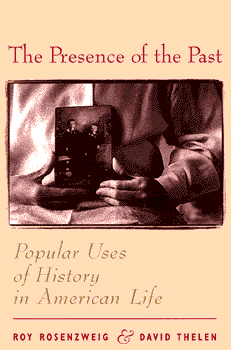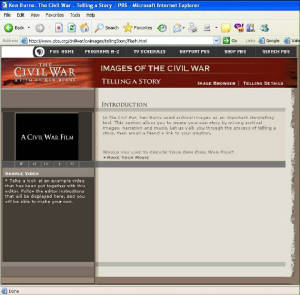|

1. The Presence of the Past: Interesting Students in U.S. History
Rationale: In 1998, Roy Rosenzweig and David Thelen published a book The Presence Of The Past: Popular Uses of History in American Life (Columbia University Press; 1998). In it, they found out that while most people consider themselves historians, they
do not consider teachers trustworthy sources for learning about the past.
Online Resources: Below is the
link to the online site of The Presence of the Past. I used this site to access the surveys and statistics I
used in making my lesson:
2. The Civil War Online - Creating Your Own Film - this site has three features. Each allow you explore the film in different ways - through images, and through
making the film yourself. This would be an excellent tool to allow you to explore the possibilities of differentiated
instruction in your classroom.
Click the image below to go to the "filmmaking" section of the website.


2. Perspectives in History - Why Teach the Study of Multiple Perspectives and Two Lessons: Pennies
in Perspective and Two Images of the Boston Tea Party
Rationale: Our student "think" history differently from trained historians. This is no surprise, but
once you read "Why Multiple Perspectives Are Imperative in Social Studies", I think you'll see how we can get them to see history as a puzzle. In the process, they may learn to enjoy history
much more.
For an actual activity, the handbook discusses Pennies and Perspective, and Comparing Revolutionary images (Boston Massacre,
Boston Tea Party).
We want our students to see every historical source as representing its own unique perspective. What will
someone in the year 2500 think of the United States when they find a penny?
What would you think of the Boston Tea Party if you only saw one perspective? The American patriots and the British saw the Boston Tea Party,
and the events surrounding it from different points of view. By looking at contrasting viewpoints, we learn
a lot about perspective. This lesson can be applied throughout all of history

3. Repeating
Themes in U.S. History
“History repeats itself”. Isn’t that
the standard answer to the question, “Why do we study history?” which confronts U.S. History teachers every year? “Because history repeats itself, and if we learn from history’s mistakes
we don’t have to repeat them” we answer. This, of course, has basis in fact.
But, simply focusing on events usually leaves the students with a narrow view.
History repeats itself over and over, not just once. Clearly, we don't learn
from our mistakes. Our current economic crisis clearly shows this. In addition, the Holocaust wasn’t
the first, or last genocide. It may surprise students to know that large-scale
genocide occurred in the world as recently as 1994 (Rwanda). Likewise, it may surprise students to know that our views on immigration haven’t
changed that much throughout history - they've only changed with respect to the immigrant group.
Ben Franklin's essay "Observations Concerning the Increase of Mankind" - this is the essay where he laments the immigration of Germans and Africans who will change the culture and "complexion"
of the United States
Pat Buchanan Immigration Article
(Jeff Jacoby): http://www.bigeye.com/jj022402.htm
Pat Buchanan Immigration Cartoon:
http://www.newsart.com/tb/tb251.htm
4. The Changing Value of Money - Using the CPI to Determine Historical Prices
Rationale: If there is one thing that everyone can identify with,
it’s money. However, money values change over time. If I say that a Chinese
immigrant paid $1625 in 1921 for fake papers to facilitate his immigration to the United States, students might say, “whoa.” But they wouldn’t have a clear idea of why they said “whoa”. They
might even say, “What is $1625 in today’s money?” The Consumer
Price Index Lesson will provide a way for you to always allow them to calculate prices into today’s value, making the
statistic more meaningful. By the way, $1625 in today's money is roughly $17,200!
Online Resources:
- Slave Auction Image
- Slave Auction Prices in New Orleans (1800-1860) - this site contains pricing information, but a lot of other interesting statistics relative to
various aspects of slave and slave ownership.
- What is the CPI? - http://www.bls.gov/cpi/cpifaq.htm
- Update your CPI Chart - this link contains the CPI
index for the current year. Simply use it to update your CPI chart. http://inflationdata.com/Inflation/Consumer_Price_Index/CurrentCPI.asp
- Online CPI Calculator - use this calculator to easily update prices:
Bureau of Labor Statistics - only goes back to 1913, but it is easy to use.
The Inflation Calculator - goes all the way back to 1800...

5. Fit the Definition - Does History Fit our One-Dimensional Definition?
Rationale: At times in history we use ‘fluid’ terms. These
are terms that, though defined, are difficult to use accurately in classifying historical figures or events. For example, today we commonly use the ‘fluid’ terms ‘liberal’ and ‘conservative’. While it is true that some politicians lean towards a certain viewpoint, they
shouldn’t be pigeon-holed into these one word ‘labels’. “Fit the Definition” is an excellent
exercise that allows students to see that definitions often are not absolute when it comes to human beings.
Defining Reconstruction Images: HarpWeek.com image of the uniting hope of Reconstruction (for some reason,
Political Prints 1776-1876 is not working. For now I am directly posting this useful image on our webpage): Reconstruction Image
Defining Progressivism Resources - the following images will allow you to compare and contrast THREE aspects of
Progressivism:
|

